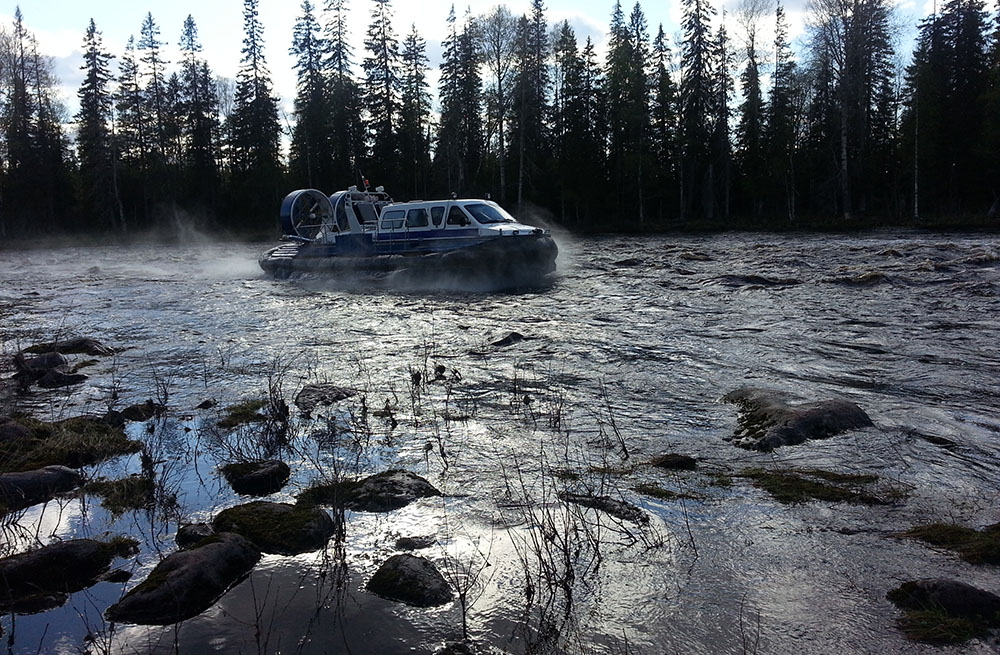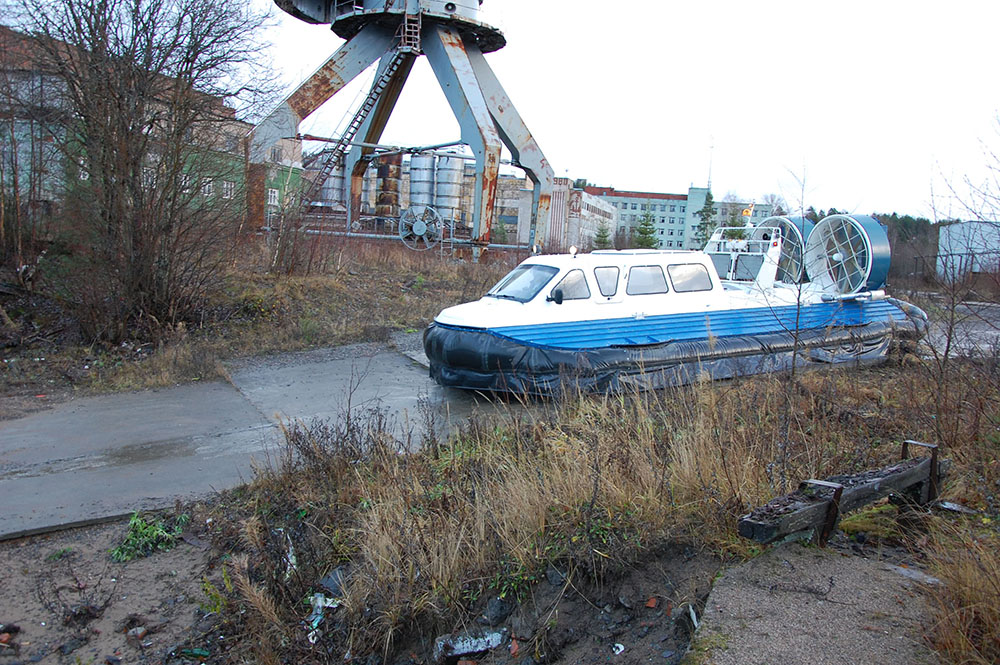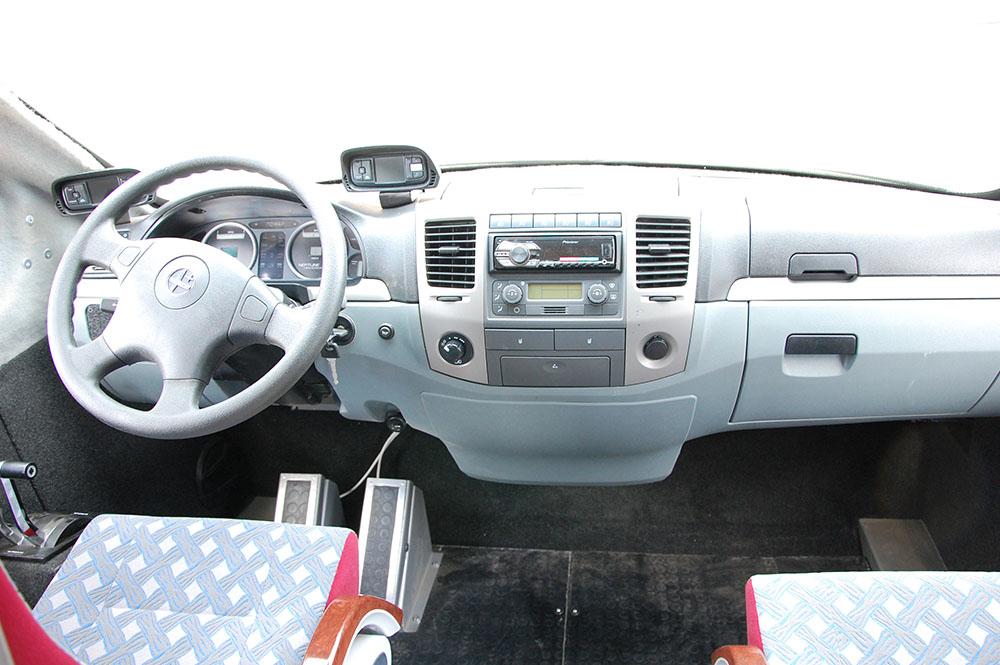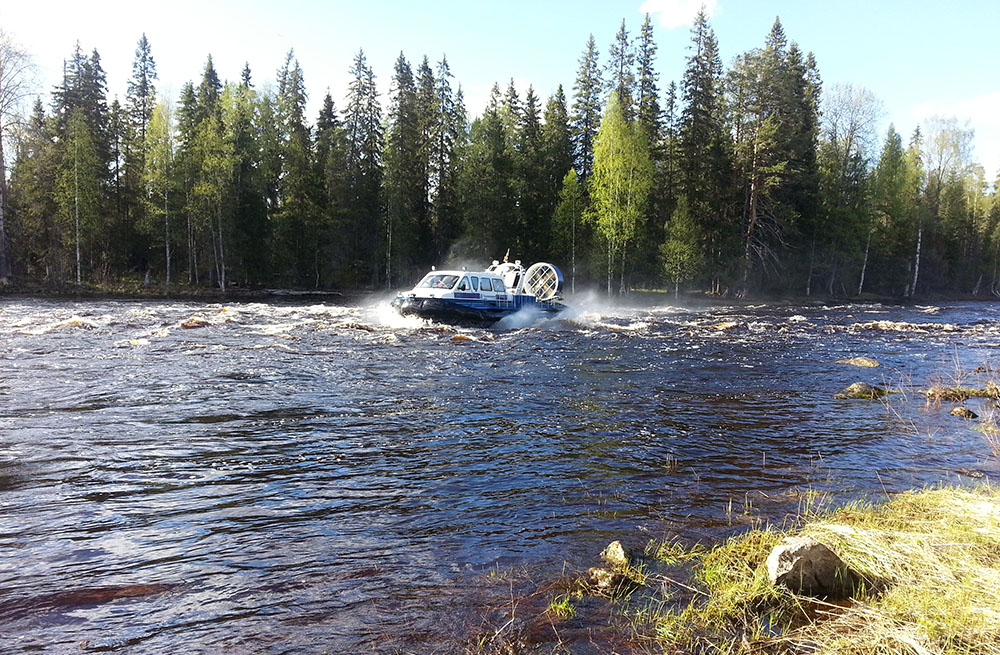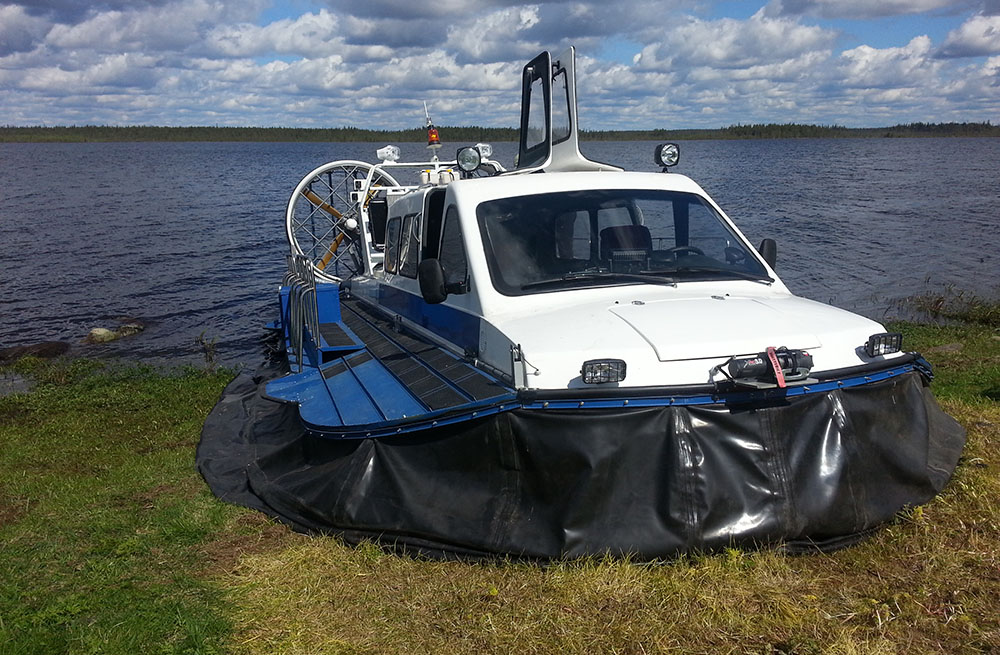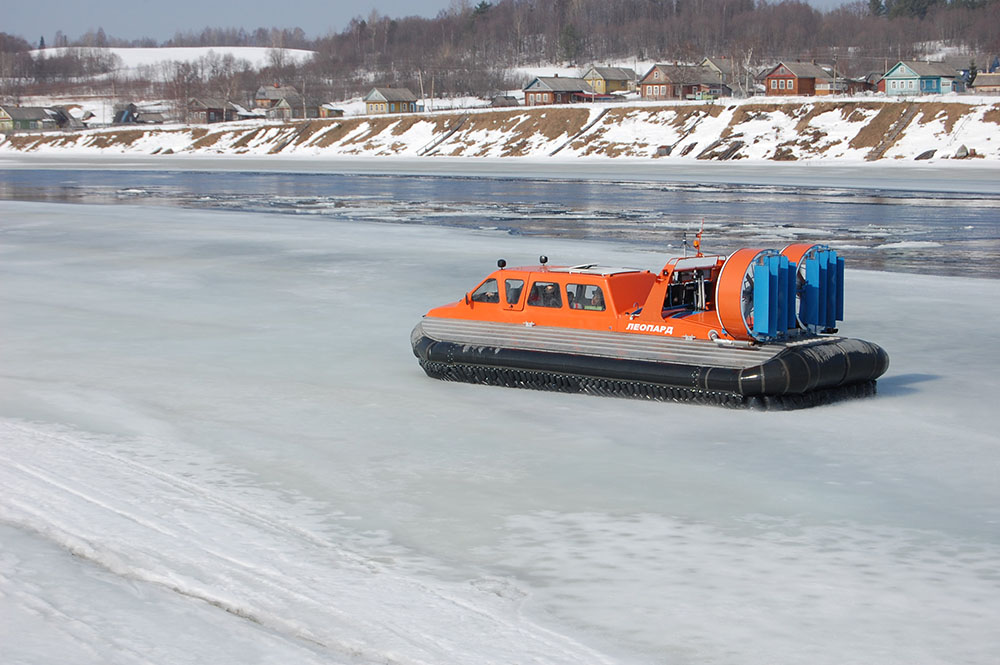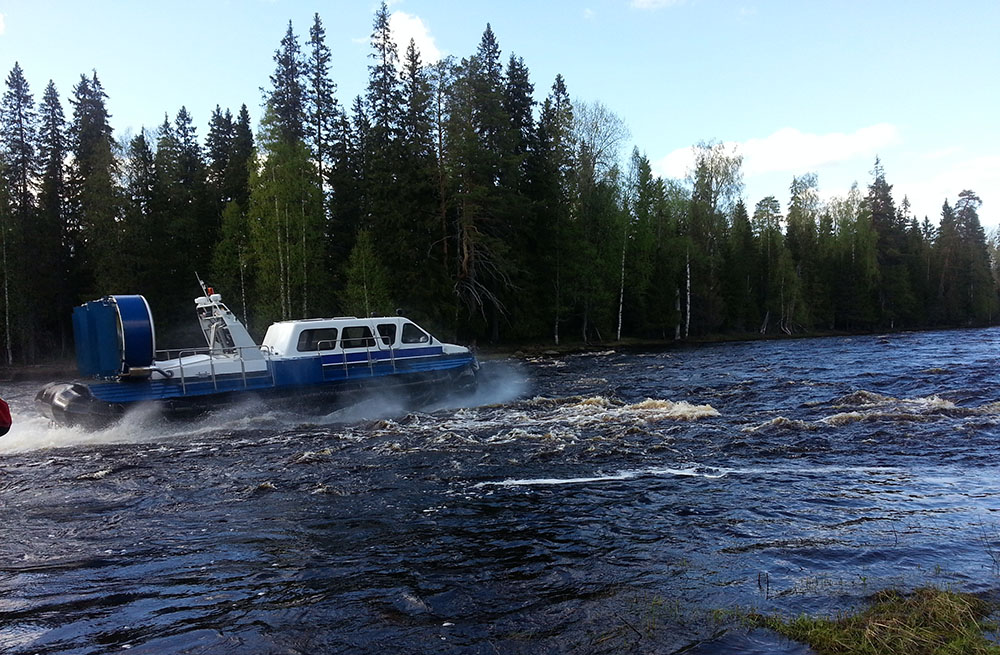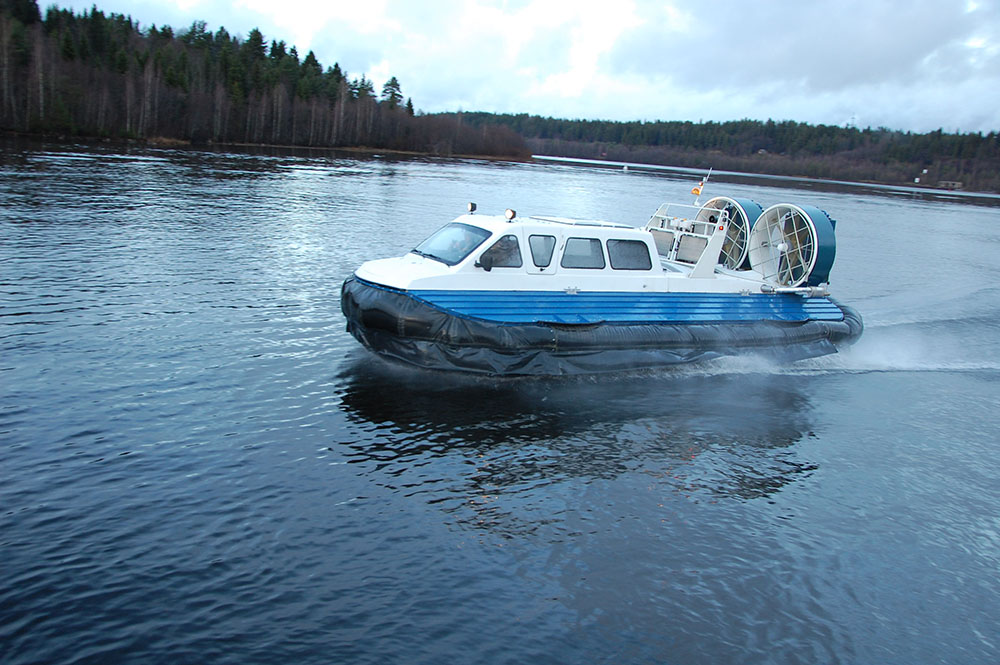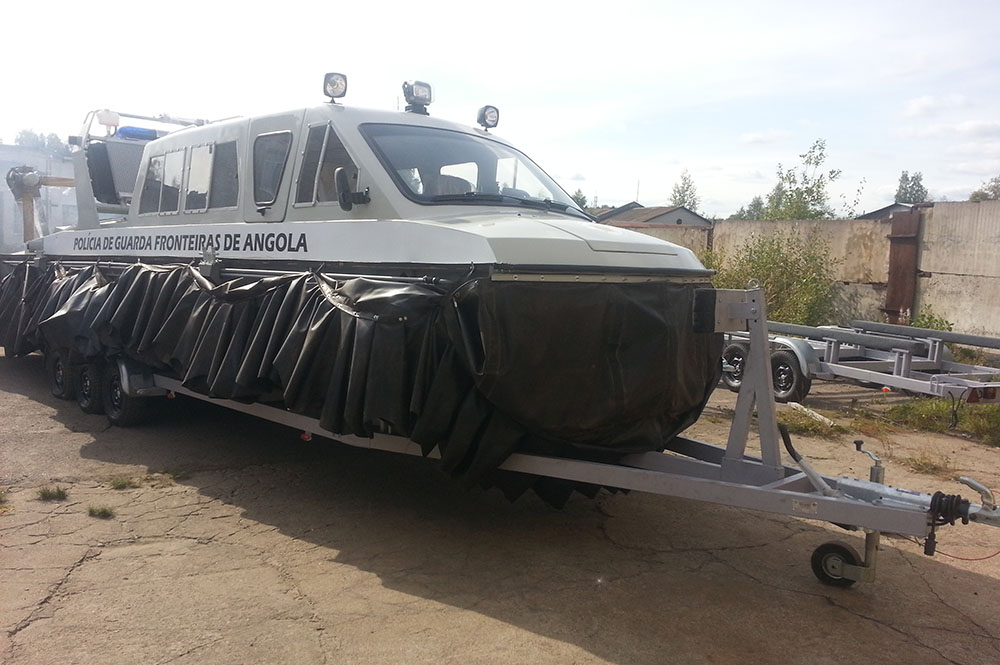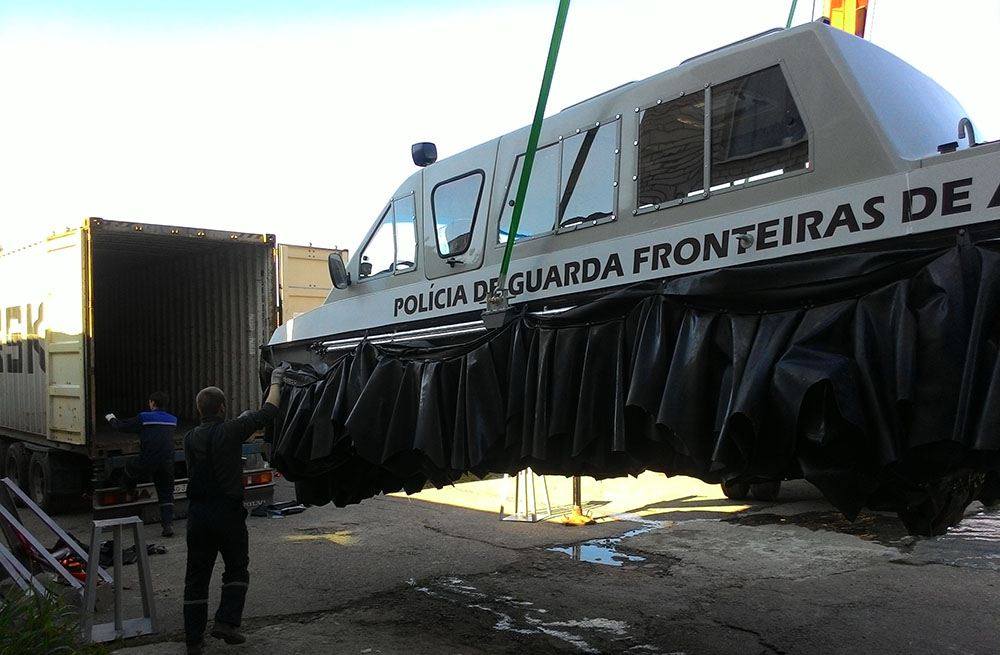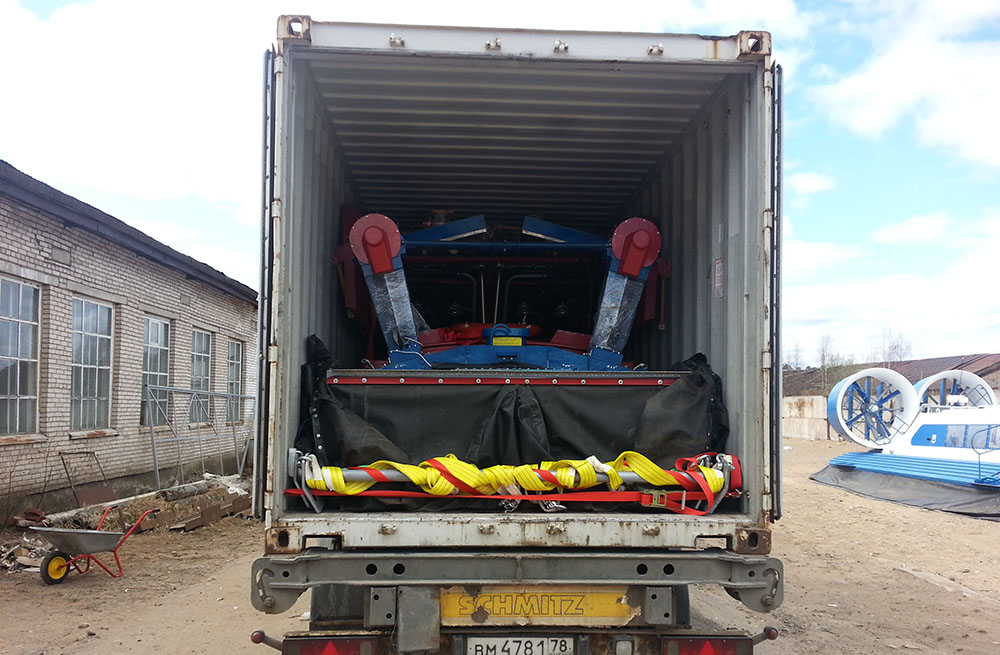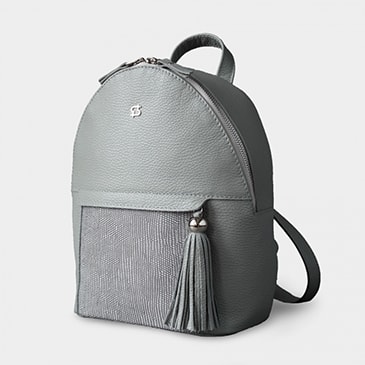15 persons

Description (download PDF presentation)
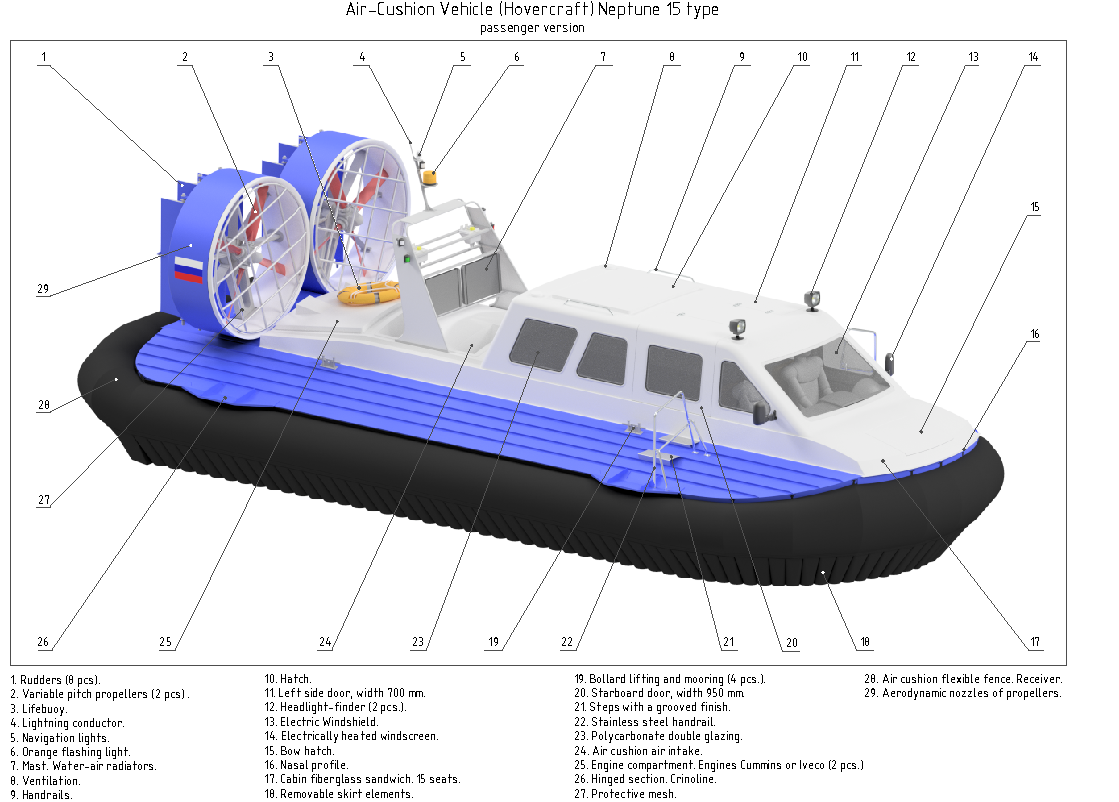
High-speed amphibious hovercraft PARMA 15 is designed to carry up to 1450 kg of cargo or up to 14 passengers. Hovercraft belongs to the class of “passenger” hovercraft and is designed to transport passengers across water bodies in summer or winter, including those with short-term shore exits. The boat is capable of overcoming smoothed ledges up to 80 cm high and not smoothed – up to 40 cm. The boat is capable of reaching a speed of about 70 km / h on water. Operation is permitted at an outside air temperature from -40 ° C to + 30 ° C and a maximum wind speed of up to 12 m / s at any time of the year during daylight hours. In all cases of load, the Hovercraft can be operated during daylight hours in water areas, with waves of no more than 1.2 m 1% security. Movement of the boat is allowed with the specified wave both in the air cushion mode and in the displacement mode. When driving on ice or snow-covered surfaces, operation is permitted on all bodies of water. Operation is allowed on any other flat solid surface, in extreme shallow water and swampy surface.
Main dimensions and characteristics
| Overall length of the hull, m | 9.1 |
| Extreme breadth of the hull (with hinged sections), m | 4.1 |
| Cushion height (clearance), m | 0.6 |
| Passenger-carrying capacity, people | 14 |
| Minimum crew, people | 1 |
| Payload, t | 1.45 |
| Service speed (on water), km / h | 45 |
| Maximum speed (on water), km / h | 70 |
| Service speed (on ice), km / h | 50 |
| Fuel reserve, l | 300 |
| Service fuel consumption on water, l / h | 24 |
| Endurance of fuel reserve, h | 12 |
| Safe wave height, m | 1.2 |
| Supervision (Option 1) | State Inspection of Small Vessels (SISV), vessel of special design up to 12 seats (hovercraft) |
| Supervision (Option 2) | River register, small up to 12 places, category * 3 |
| Supervision (Option 3) | River register, passenger 15 seats, class Р * 1.2 / 1.2 hovercraft |
Housing
The hull of the vessel is made watertight, divided into 5 watertight compartments by 5 watertight bulkheads. As the material of the main body, set, foundations, sheet and profile rolled products from aluminum alloys are accepted. Flat products are used of the Amg5M brand, all-Union State Standard 21631-76. Profile rolled products of the Amg6M or D16T grade in accordance with all-Union State Standard 8617-75. The body of the hovercraft is riveted (with the exception of small parts made by welding). The tightness of the outer contour of the boat and the corresponding transverse bulkheads is ensured. The tightness test is carried out in accordance with the test scheme and table. Corrosion protection of the body is provided by the use of aluminum-magnesium alloys, which are resistant to corrosion in river and sea water. Additionally, it is envisaged to paint the outer and inner surfaces of the body with paint and varnish materials.
Salon
The passenger compartment is equipped in the front with two soft passenger seats, including one for the captain. Along the sides, there are six double lifting sofas-lockers, under which lifejackets and property are located. The covers of the sofas can be folded out, forming a sleeping place measuring 1800×2000 mm in the aft part of the cabin. The arrangement of armchairs and sofas is subject to change. There is an option with soft seats for all passengers. The deckhouse is made of a three-layer structure, the middle layer of which is insulation. The outer layer is made of fiberglass based on polyester resin with fiberglass reinforcing material, coated with a colored resin (gelcoat). The middle layer is made of tiled foam. The inner layer is made of fiberglass, pasted over with a lining – pile fabric
Engine
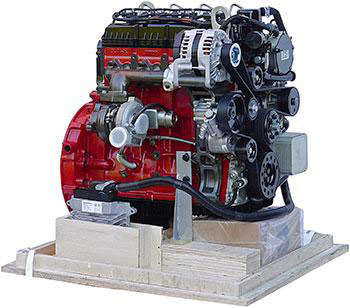
The hovercraft is equipped with two engines of the American brand Cummins ISF 2.8, 130 hp each. An increase in power up to 150 hp is possible. by increasing the maximum crankshaft speed. A four-stroke, four-cylinder, electronic Common Rail diesel engine with in-line cylinders and common crankshaft pistons, with single overhead camshaft. The engine has a closed-type forced circulation liquid cooling system. Combined lubrication system: under pressure and spray. The Kamins 2.8 (Cummins ISF 2.8L) engine is installed on vehicles manufactured by OJSC GAZ, in particular, on commercial vehicles of the GAZelle Business and GAZelle NEXT families. Due to its prevalence, the engine is well known to services, and spare parts and consumables for it are not expensive and can be easily found in stores. Today we can safely say that this engine is the most widespread commercial diesel in Russia. The engine is equipped with low temperature starting aids. An electric coil is provided for heating the air in the intake manifold. The fuel filter is also electrically heated. The Cummins ISF 2.8 engine has very low fuel consumption. The engines are standardly equipped with a turbocharger with an intercooler, that is, with pre-cooling of the air supplied to the charge. Thanks to the use of turbocharging, it was possible to provide high power and torque with a sufficiently small volume. At the same time, the presence of a turbine does not impair the efficiency of the engine – its fuel consumption per vehicle ranges from 8.5 to 10.3 l / 100 km, depending on the speed and operating mode. The engine has a traditional design. It is based on a one-piece cylinder block (made of gray cast iron) and a cast head; inserted milled liners are used in the block, which facilitates cylinder repair. The crankshaft is also made of gray cast iron and is integrated with the crankshaft position sensor pulley and toothed disk. The camshaft is one, located at the top. The motor has 16 valves (4 per cylinder), made of heat-resistant steel, their stems are additionally chrome plated. The valve drive is traditional, through rocker arms. Interestingly, all valves have the same design, but are not interchangeable. Timing drive – chain. The engine is equipped with Bosch Common Rail fuel equipment, the fuel injectors are top-mounted, they are installed in the central part of the cylinder. This solution has greatly simplified the engine without significantly degrading its performance. In general, the Cummins ISF 2.8 is a simple, reliable and unpretentious engine with good characteristics and adapted for operation in Russian conditions. Thanks to the design features, a simple device and the use of time-tested solutions, it was possible to achieve a high resource – the manufacturer claims an engine resource of up to 500 thousand km (for a car), in practice, the engine can last longer with proper operation and maintenance. The engine is currently being manufactured at the Cummins FOTON joint venture in China.
| Type of engine | 4-stroke 4-cylinder Cummins ISF 2.8s 3129T |
| Number of engines, pcs. | 2 |
| Power, h.p. (kw) | 130 (96) х2 |
| Maximum speed, rpm | 3200 |
| Working capacity, cubic cm | 2781 |
| Compressive ratio | 16:1 |
| Fuel-oil system | Common Rail от Bosch |
| Maximum fuel consumption of one engine, kg / h | 21 |
| Cooling system | Liquid |
| Motor maintenance weight, kg | 214 |
The amphibious qualities of the hovercraft are provided by the separation of the body from the screen due to the holding of an air cushion under the body by a flexible fence. The lift height depends on the speed of the blowers (engines) and the trim angle. The hovercraft adopted a two-tier flexible fencing scheme with removable elements along the entire perimeter of the lower tier and with a flexible receiver in the upper tier. This scheme allows removable elements to remain elastic. Those. when passing through obstacles, the flexible elements deflect and pass the object under them without resisting its impact.
Only the lower segment tier, which consists of many independent elements, participates in contact with the surface. Each element is attached to the receiver with four clamps. Replacement is simple and requires no special tools or skills. Due to the constant air flow in the airspace, the HE will retain the ability to move the hovercraft even if all removable elements are lost. GO material – rubberized fabric based on rubber nylon. This fabric allows you to expand and take a given shape in low temperatures. The maximum achievable height of the air cushion is about 0.6 m. The height of the air cushion is measured from the supporting solid surface to the bottom of the hull.
Air bubble propellers and blowers
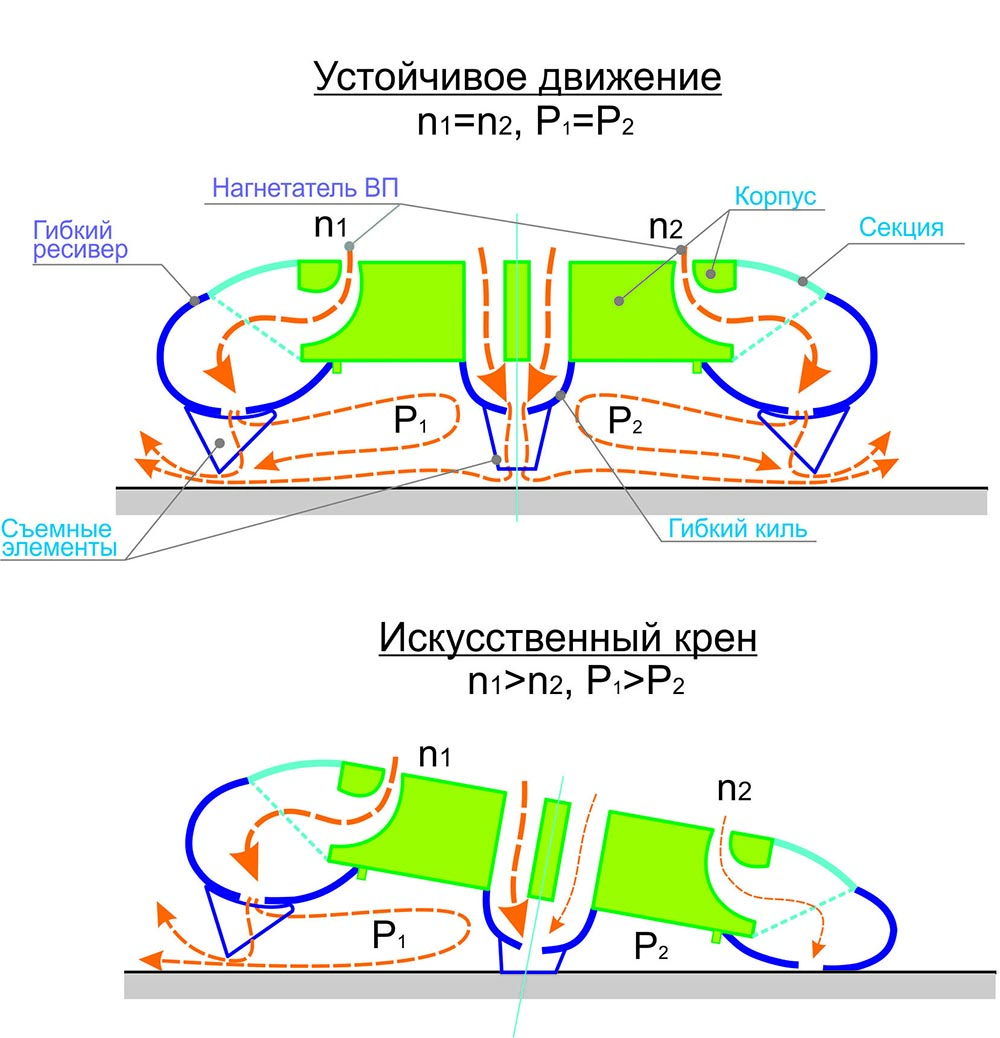
As propellers on the hovercraft, there are two four-blade propellers of variable pitch in aerodynamic fixed nozzles. The support unit of the variable pitch propeller and the reverse mechanism are located in the pylons of each nozzle. The propeller blades are made of fiberglass composite coated with aramid. The angle of rotation of the propeller blades is controlled by direction indicators installed in the control panel.
Two twin centrifugal blowers are provided as air cushion blowers. The air cushion blowers operate separately, each on its own side. The blowers are mounted on shafts supported on both sides by self-aligning bearings. The blowers are made of fiberglass, carbon fiber and aramid. Separate control of the speed of the blowers (n1 and n2) and the sectioning of the air cushion zones allow creating different pressures in the left P1 and right P2 halves.
This property makes it possible to create an artificial bank, which greatly helps with maneuvers and helps to neutralize the effect of side wind gusts. In the event of a failure of the engine or the supercharger of one of the sides, the jumper between the zones is removed and the flexible fence is filled with air from the working supercharger. The hovercraft can continue to move on one supercharger.
Control
Directional control is provided by turning the steering wheel in the helm station and rudders installed in the stream behind the propellers. Rotation of the rudders provides control torque with the center of rotation in the nose area. Provision is made for shifting propellers of variable pitch from FORWARD to REVERSE. Shifting is done both jointly and separately by pedals located at the driver’s feet. The split shift provides a control torque with the center of rotation in the stern area. The propeller speed control is provided, which provides different thrust and creates a control torque with the center of rotation in the stern area. The possibility of hovering on an air cushion at low speeds is provided by installing the propeller blades in several intermediate positions in the range of angles from full forward to full rear. Shifting of the blade of one propeller backward is provided, corresponding to the shift of the blade of the other propeller forward (work in disarray) Remote control of the power plant is performed by levers located on the control panel.
Registration
Hovercraft is being built in accordance with the Russian River Register class “R * 1.2 / 1.2 hovercraft”. This allows you to operate it for personal and business needs without the right to commercial exploitation. Number of seats up to 11 people.
Swimming is allowed – GDP not higher than “P”. State Inspection of Small Vessels (SISV). Amateur rights. Currently, the term of project approval with RRP has been completed and further approval was not carried out due to the lack of demand for this service from customers. On a separate order, it is possible to reconcile the project with the River Register to obtain the right to commercial exploitation and legal transportation of passengers.
Passenger – any person on board a ship, except for the captain and crew members or other persons working or having any occupation related to the activities of this ship (special personnel), as well as a child under one year old.
Transportation
Hovercraft can be transported on a special trailer, in one 40-foot container, auto-trailer with a trailer length of 10 meters.
Systems
Hovercraft is equipped with the following systems: electric (12V, 2 batteries)
fuel (300 liters)
engine cooling
gas exhaust (stainless)
ventilation of the passenger compartment and engine compartment trimming (90 liter tanks in the bow and stern)
steering (two groups behind the nozzles, 4 rudders each)
Other
Hovercraft is standard equipped with:
life jackets by the number of passengers
two xenon headlights on the handle
two water-air heaters for the passenger compartment from different engines
The variable-pitch propeller
The windscreen washer and wipers
The trim indicator
two on-board diagnostic computers Multitronics (engine speed, voltage, remaining fuel in tanks, coolant temperature, errors)
indicator of the angle of attack of the propeller blades; indicator “Fire” in the engine compartment
electric amplifiers the variable-pitch propeller
dehumidification pumps
gullwing doors 750 mm wide
radio tape recorder, cup holders, glove boxes, cigarette lighter, ashtray, etc.
Videos
 Youtube
Youtube

